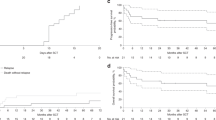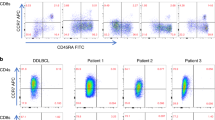Abstract
Post-transplant lymphoproliferative disorder (PTLD) is a complication of allogeneic bone marrow transplantation (BMT). Rare cases of PTLD after autologous BMT have been reported only in adults. This case report is the first to describe PTLD in a pediatric patient after autologous peripheral stem cell transplantation (PSCT). This 2-year-old male with stage IV neuroblastoma underwent autologous PSCT. The post-PSCT course was complicated by fever with hematochezia and a lung mass. On day 94 post PSCT, colonoscopy revealed an ulcer due to a PTLD, monomorphic type, B cell phenotype, associated with Epstein–Barr virus. Fine needle aspiration identified the lung mass as neuroblastoma. PTLD can occur in pediatric autologous PSCT recipients, and may occur more frequently in autologous grafts manipulated by T cell depletion or CD34+ cell selection. Bone Marrow Transplantation (2000) 26, 1021–1024.
This is a preview of subscription content, access via your institution
Access options
Subscribe to this journal
Receive 12 print issues and online access
$259.00 per year
only $21.58 per issue
Buy this article
- Purchase on Springer Link
- Instant access to full article PDF
Prices may be subject to local taxes which are calculated during checkout




Similar content being viewed by others
References
Orazi A, Hromas RA, Neiman RS et al. Post-transplantation lymphoproliferative disorders in bone marrow transplant recipients are aggressive diseases with a high incidence of adverse histologic and immunobiologic features Am J Clin Pathol 1997 107: 419–429
Young L, Alfieri C, Hennessy K et al. Expression of Epstein–Barr virus transformation-associated genes in tissues of patients with EBV lymphoproliferative disease New Engl J Med 1989 321: 1080–1085
Anderson KC, Soiffer R, DeLage R et al. T cell-depleted autologous bone marrow transplantation therapy: analysis of immune deficiency and late complications Blood 1990 76: 235–244
Chao NJ, Berry GJ, Advani R et al. Epstein–Barr virus-associated lymphoproliferative disorder following autologous bone marrow transplantation for non-Hodgkin's lymphoma Transplantation 1993 55: 1425–1428
Shepherd JD, Gascoyne RD, Barnett MJ et al. Polyclonal Epstein–Barr virus-associated lymphoproliferative disorder following autografting for chronic myeloid leukemia Bone Marrow Transplant 1995 15: 639–641
Briz M, Fores R, Regidor C et al. Epstein–Barr virus associated B cell lymphoma after autologous bone marrow transplantation for T cell acute lymphoblastic leukemia Br J Haematol 1997 98: 485–487
Hauke RJ, Greiner TC, Smir BN et al. Epstein–Barr virus-associated lymphoproliferative disorder after autologous bone marrow transplantation: report of two cases Bone Marrow Transplant 1998 21: 1271–1274
Peniket AJ, Perry AR, Williams CD et al. A case of EBV-associated lymphoproliferative disease following high-dose therapy and CD34-purified autologous peripheral blood progenitor cell transplantation Bone Marrow Transplant 1998 22: 307–309
Lones MA, Lopez-Terrada D, Shintaku IP et al. Post-transplant lymphoproliferative disorder in pediatric bone marrow transplant recipients: disseminated disease of donor origin demonstrated by fluorescence in situ hybridization Arch Pathol Lab Med 1998 122: 708–714
Harris NL, Ferry JA, Swerdlow SH . Post-transplant lymphoproliferative disorders: summary of Society for Hematopathology Workshop Sem Diagn Pathol 1997 14: 8–14
Holmberg LA, Boeckh M, Hooper H et al. Increased incidence of cytomegalovirus disease after autologous CD34-selected peripheral blood stem cell transplantation Blood 1999 94: 4029–4035
Papadopoulos EB, Ladanyi M, Emanuel D et al. Infusions of donor leukocytes to treat Epstein–Barr virus-associated lymphoproliferative disorders after allogeneic bone marrow transplantation New Engl J Med 1994 330: 1185–1191
Rooney CM, Smith CA, Ng CYC et al. Use of gene-modified virus specific T lymphocytes to control Epstein–Barr virus-related lymphoproliferation Lancet 1995 345: 9–13
Fischer A, Blanche S, Le Bidois J et al. Anti-B cell monoclonal antibodies in the treatment of severe B cell lymphoproliferative syndrome following bone marrow and organ transplantation New Engl J Med 1991 324: 1451–1456
Faye A, Van Den Abeele T, Peuchmaur M et al. Anti-CD20 monoclonal antibody for post-transplant lymphoproliferative disorders Lancet 1998 352: 1285
Cook RC, Connors JM, Gascoyne RD et al. Three patients with diffuse large B cell type of post-transplant lymphoproliferative disease with rituximab monoclonal antibody after lung transplantation Lancet 1999 354: 1698–1699
Manez R, Breinig MC, Linden P et al. Post-transplant lymphoproliferative disease in primary Epstein–Barr virus infection after liver transplantation: the role of cytomegalovirus disease J Infect Dis 1997 176: 1462–1467
Author information
Authors and Affiliations
Rights and permissions
About this article
Cite this article
Lones, M., Kirov, I., Said, J. et al. Post-transplant lymphoproliferative disorder after autologous peripheral stem cell transplantation in a pediatric patient. Bone Marrow Transplant 26, 1021–1024 (2000). https://doi.org/10.1038/sj.bmt.1702593
Received:
Accepted:
Published:
Issue Date:
DOI: https://doi.org/10.1038/sj.bmt.1702593
Keywords
This article is cited by
-
A pilot study of tandem high-dose chemotherapy with stem cell rescue as consolidation for high-risk neuroblastoma: Children’s Oncology Group study ANBL00P1
Bone Marrow Transplantation (2013)
-
The central nervous system complications of bone marrow transplantation in children
European Radiology (2008)
-
GI complications in pediatric patients post-BMT
Bone Marrow Transplantation (2005)
-
T-cell large granular lymphocytic leukemia occurring after autologous peripheral blood stem cell transplantation
Bone Marrow Transplantation (2004)
-
An unexpectedly high incidence of Epstein–Barr virus lymphoproliferative disease after CD34+ selected autologous peripheral blood stem cell transplant in neuroblastoma
Bone Marrow Transplantation (2004)



